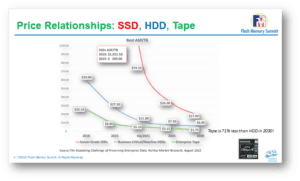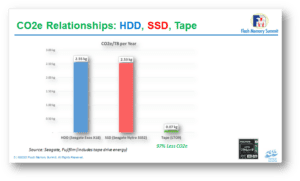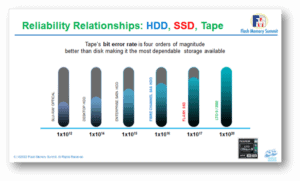![]()
I had the opportunity to attend in person and present on the latest in tape technology at the 16th Annual Flash Memory Summit (FMS) held in Santa Clara last week. That’s right, tape technology at a flash conference. My friends from the DNA Data Storage Alliance were there presenting too. So what gives?
Well, first of all let me say, as the organizer of the Fujifilm Global IT Executive Summit, I was really impressed with the quality and scale of the show. It was my first FMS, and I wasn’t quite prepared for a General Session ballroom set for 1,500 people or so (plus overflow space and monitors in the outside hallway like a good evangelical church). Compliments to Tom Coughlin, Chuck Sobey and so many others for putting on a well-organized and content rich program.
Cold Storage Supports Hot Storage
So back to the question, what gives in terms of cold storage having a seat at a hot storage show? I was kind of wondering about this myself and honestly never thought that my abstract to talk about tape would be accepted. But it was.
Coming from the East Coast, I arrived the day before the official opening so I went to get my badge and do a little recon. I had the luck to run into Chuck Sobey as he was making the rounds and checking on everything. While we chatted, Chuck mentioned that he and the FMS committee were considering a specific archive agenda for FMS 2023 and would I be interested in that? Of course!
The next day my break-out panel on data storage was bright and early but I had a good time working with our panel moderator, Jean Bozman of Cloud Architects Advisors, and fellow panelists Wim De Wispelaere of Western Digital and Javier Gonzalez of Samsung.
The title of my presentation was “Leveraging Tape to Support Primary Flash Storage.” My very basic agenda covered the following points:
So that’s how you leverage tape to support primary flash storage. You move cold data that’s gone static and inactive but can’t be deleted, from expensive, energy intensive primary storage tiers to low cost, eco-friendly tiers of storage like tape. An IBM executive once said, “the best way to afford more flash is to deploy tape systems.”



Explosion of Data That Needs to Be Stored
After our data storage panel, I attended the larger general session keynote presentations from the big flash companies like Kioxia (formerly Toshiba), Western Digital, Samsung, SK Hynix, Marvell, Intel and others.
What struck me was the amazing amount of innovation happening in CPUs, GPUs, DPUs and memory at the very top of the “pyramid” such as SRAM, DRAM and SCM (storage class memory). New data intensive workloads and applications are exploding including real-time analytics, AI/ML, VR/AR, IoT, HPC, and cybersecurity just to name a few. In support of these workloads and applications, significant advances are happening in speed, cost performance, power consumption, and scalability.
This, of course, is increasing not only the amount of data that is being generated, but increasing its value as well. Increasing amounts of valuable data will need to be stored for longer periods of time. The more data we can save the better for analytics. But in order to do this cost effectively, reliably and in an energy conscious manner, the industry is going to need increasing amounts of archival storage like tape (think active archive), DNA (think deep archive) and maybe yet to be developed hybrid or new storage solutions.
So that’s why tape and DNA were at Flash Memory Summit and why we hope to see more dedicated archival content at FMS 2023.
